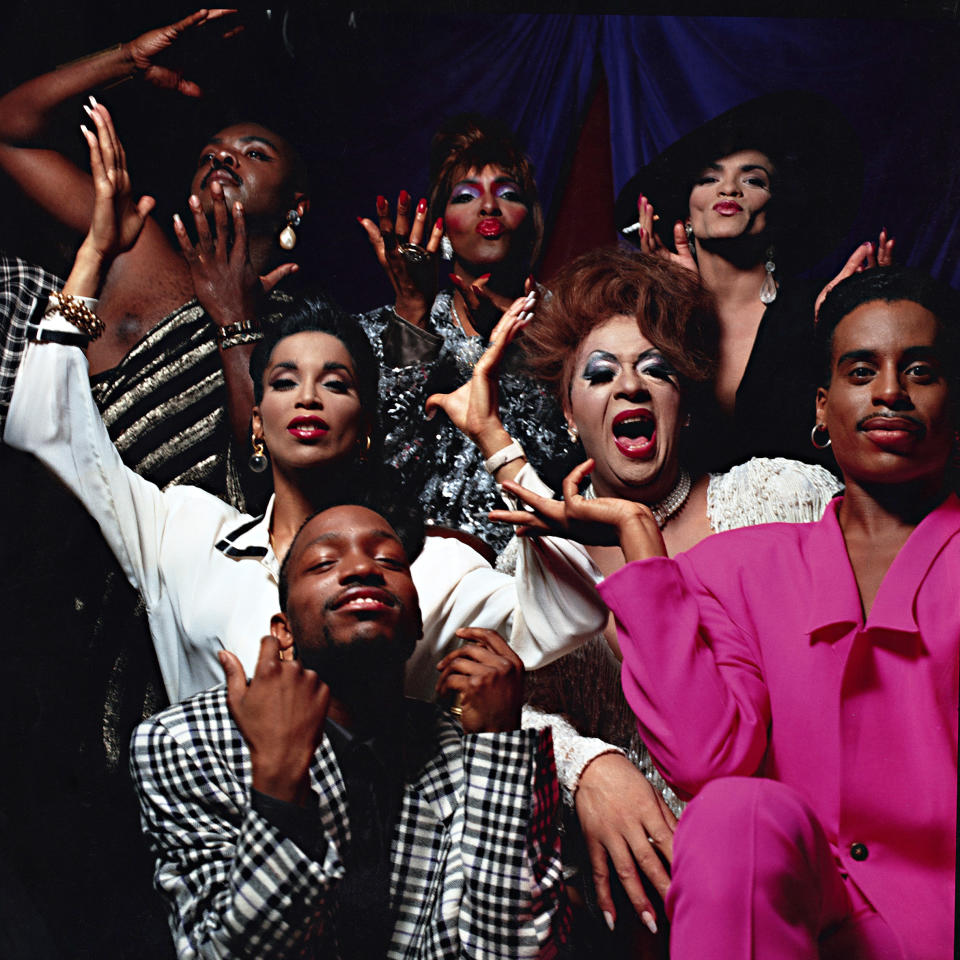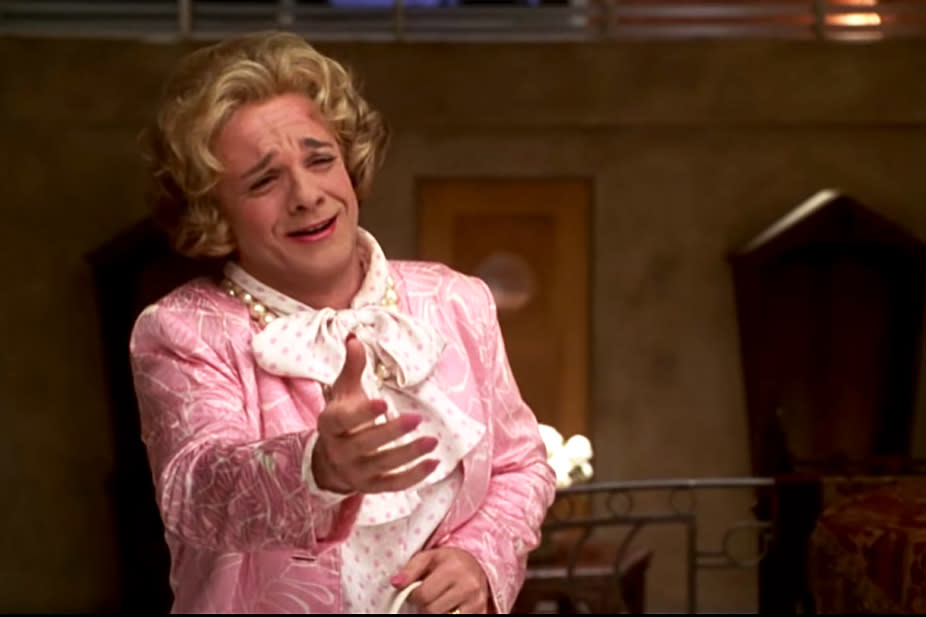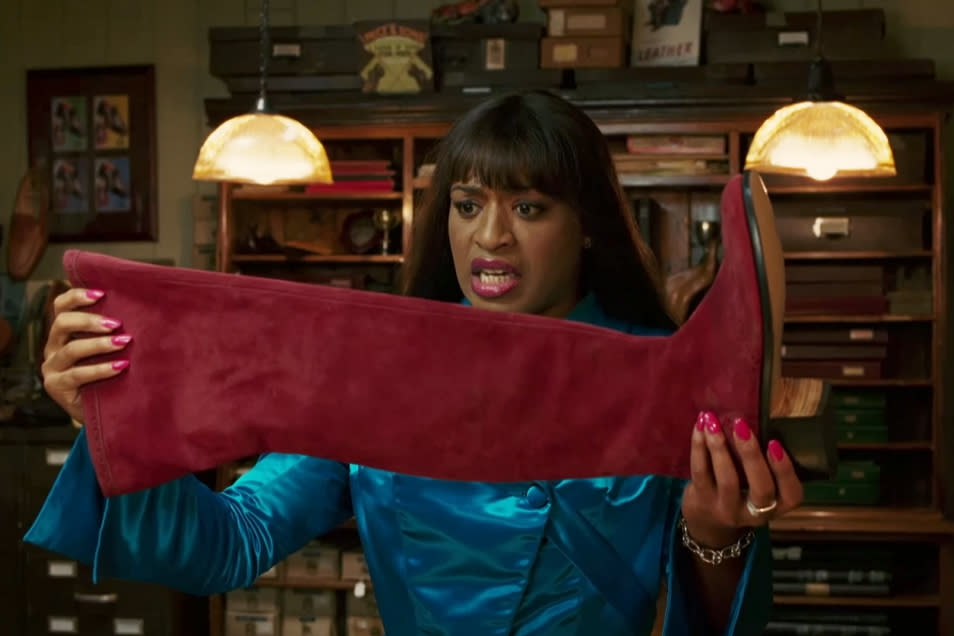11 essential drag films from the ‘50s to early aughts to watch this Pride month
- Oops!Something went wrong.Please try again later.
- Oops!Something went wrong.Please try again later.
- Oops!Something went wrong.Please try again later.
- Oops!Something went wrong.Please try again later.
- Oops!Something went wrong.Please try again later.
In the past almost decade and a half, “RuPaul’s Drag Race” has become synonymous with drag queens onscreen. But before the show launched in 2009, drag, a centuries-long art form, had a rich history on film, thanks to its cinema-worthy aesthetic and eras of public fascination.
From the late 1950s, when movies defied censors to depict gender-bending themes, to the early aughts, drag queens have inspired groundbreaking documentaries and campy narrative films featuring the world’s biggest stars. While these films have often fallen short of representing the richness of drag, they’ve been embraced as cannon by the queer community. And they continue to be touch points for generations of LGBTQ people who embrace the good, bad and everything but ugly of drag on the big screen.
‘Some Like It Hot’ (1959)
In Billy Wilder’s “Some Like It Hot,” Tony Curtis and Jack Lemmon play opposite Marilyn Monroe as musicians who don drag to elude the mob and join an all-female band headed to Miami. Their plan starts to get more complicated when Joe (Curtis), or Josephine in drag, falls for the troupe’s glamorous lead singer, Sugar Kane (Monroe), and begins moonlighting as a fictional, emotionally stunted millionaire to win her heart. Jerry (Lemmon) then ends up with millionaire problems of his own, as one of the seaside resort’s male audience members begins courting the double bass player’s female persona, Daphne. Somehow, the cat-and-mouse romance makes for the film’s most progressive moment, when the noticeably unladylike Daphne — likely a result of Lemmon’s resistance to being coached onset by the high-wire performer and drag artist Barbette — contemplates whether the much older suitor may just be her prince charming.
‘The Queen’ (1968)
More than two decades before Jennie Livingston’s “Paris Is Burning” brought New York City drag balls to the masses, director Frank Simon profiled contestants in the 1967 Miss All-America Camp Beauty Pageant, which attracted the likes of Andy Warhol as a judge. At the center of the documentary is Flawless Sabrina, the organizer of the pageant and a prominent figure in the early ball scene, an underground subculture of pageant-style competitions started by queer people of color. While there are many memorable moments in the film, the most significant is drag performer Crystal LaBeija’s onscreen reaction to the announcement of the winner: a young, white queen from Philadelphia who exemplifies the Eurocentric ideals reportedly prized in the early years of pageants. LaBeija, who is credited with starting the house system, which provides young LGBTQ people with chosen families, accuses Sabrina of fixing the contest, repeating another queen’s warning that Black contestants never stood a chance. The moment marked a shift in ball culture and foreshadowed the rise of the legendary Harlem queens of the ‘70s and ‘80s.
‘Pink Flamingos’ (1972)
Following his premature death in 1988, the legendary drag queen Divine has lived on in the works of fringe artists and mainstream creators, including as the inspiration for the buxom sea witch Ursula, who first appeared in 1989’s “The Little Mermaid.” But he’s perhaps best remembered by cinema fans for his starring role in John Waters’ disturbing, trash cinema classic “Pink Flamingos.” In the film, Divine plays the matriarch of a deranged group of outcasts who commit more and more depraved acts to earn the title of “the filthiest person alive.” And in addition to shocking audiences and angering censors — for, among other things, Divine eating dog feces onscreen — it debuted what would become its leading lady’s signature look, developed with the help of costume designer and makeup artist Van Ness. In the film’s most infamous scene, the shapely, pistol-wielding queen appears in a red mermaid dress, with a shaved-back hairline, teased ponytail and extreme, arched brows that accentuate the homicidal glint in her eye.
‘The Rocky Horror Picture Show’ (1975)
In the film adaptation of Richard O’Brien’s musical “The Rocky Horror Picture Show,” Tim Curry plays Dr. Frank-N-Furter — the role he originated for the stage — an intergalactic “sweet transvestite, from Transexual, Transylvania.” As the film opens, two stranded newlyweds, Brad and Janet (Barry Bostwick and Susan Sarandon), come knocking at Frank-N-Furter’s gothic mansion, right as he’s hosting the annual Transylvanian Convention and readying to unveil his newest creation: a muscled take on Frankenstein’s monster named Rocky. From there, the evening only gets even weirder as the monstrous and oversexed attendees perform bizarre rituals, like a choreographed “Time Warp” routine, and hop from bed to bed, leaving Brad and Janet with little choice but to let their WASP-y hair down and join in the festivities. When it was released, the rollicking parody of early sci-fi B-movies inspired flocks of fans to attend midnight screenings armed with costumes and props and mime the over-the-top scenes as they played onscreen — creating a tradition that survives to this day.
‘Victor/Victoria’ (1982)
Filmmaker Blake Edwards’ remake of the 1933 German film “Viktor und Viktoria” imagines a glitzy Parisian world in which male impersonators reign supreme. In the film, Julie Andrews, who was married to Edwards for more than four decades, plays an out-of-work singer who’s struggling to find employment in Depression-era Europe when she meets Toddy, an aging, gay cabaret performer. Toddy, who is played by Robert Preston (“The Music Man”), sells the singer on charading as a “male female impersonator” named Victor, who goes by the stage name Victoria. And under the nightlife veteran’s tutelage, Victor/Victoria takes the city’s cabaret scene by storm — even attracting the attention of a Chicago gangster, played by James Garner, who refuses to believe he’s fallen for a man. While very much a mainstream film, the Oscar-winning musical sex farce presents this convoluted, gender-bending plot with a lot of openness and heart and remains a rare example of a big studio film centering on a woman in male drag.
‘Paris Is Burning’ (1990)

When director Jennie Livingston released her groundbreaking documentary “Paris Is Burning,” it was many viewers’ first exposure to New York City’s underground ball scene. At the heart of the documentary are four towering figures: Willi Ninja, Pepper LaBeija, Dorian Corey and Venus Xtravaganza. In intimate interviews from their cramped New York apartments, these legendary artists school Livington on what it means to be the mother of a premiere drag “house” and how to score big in different ball categories. These interview clips are interspersed with footage from the balls, showing the veterans and freshed-faced contestants voguing, strutting the catwalk and making grand entrances in an effort to take home more sky-high trophies. But the documentary isn’t jubilant all the way through, as by the end of filming, many of the figures’ lives have been forever changed by the AIDS epidemic.
‘The Adventures of Priscilla, Queen of the Desert’ (1994)
Stephen Elliot’s Oscar-winning film, “The Adventures of Priscilla, Queen of the Desert,” stars Hugo Weaving, Guy Pearce and Terence Stamp as a troupe of drag queens traveling through the Australian desert on a bus dubbed Priscilla, en route to a remote casino residency. The exuberant journey, which is fueled by the tunes of disco divas like Donna Summers and Gloria Gaynor, begins when Sydney-based Anthony “Tick” Belrose (Weaving) enlists his fellow performers Adam (Pearce), a young queen with a storied ego, and Bernadette (Stamp), a recently bereaved transgender woman looking for an escape, to join him in Alice Springs. On the windy, often treacherous road to the residency, the makeshift ensemble stages impromptu performances, fights off homophobic locals and comes to learn one another’s secrets, one of which may just derail the whole venture. Like other titles from the era, the visually compelling road-trip movie has had a complicated legacy because of its handling of race and arguably problematic casting, and yet is still considered essential queer cinema.
‘To Wong Foo, Thanks for Everything! Julie Newmar’ (1995)
Since its release in the mid-‘90s, “To Wong Foo, Thanks for Everything! Julie Newmar“ — which stars Patrick Swayze, Wesley Snipes and John Leguizamo — has been a point of contention among queer audiences, with some lauding it as groundbreaking and others taking issue with its desexualized characters, casting and reliance on racial stereotypes. In the film, which bears a striking similarity to “Priscilla, Queen of the Desert,” New York queens Vida (Swayze) and Noxeema (Snipes), accompanied by novice Chi Chi (Leguizamo), set off on a road trip to Los Angeles to compete for the title of Miss Drag Queen of America. But along the way, their car breaks down while fleeing a sleazy cop and they get stranded in the small, conservative town of Snydersville. For their own protection, they try to convince the townsfolk they’re women, rather than drag queens, which means they even have to go to bed in drag. But it turns out that the locals are more interested in the trio’s problem-solving abilities than their gender identities, enlisting them to help with everything from an abusive marriage to a strawberry festival before the week is out.
‘The Birdcage’ (1996)

In the ‘90s remake of “La cage aux folles,” Robin Williams and Nathan Lane star as Armand and Albert Goldman, life partners who run a South Beach drag club called the Birdcage and are fathers to a clean-cut son named Val. When Val (Dan Futterman) proposes to his all-American girlfriend, Barbara Keeley (Calista Flockhart) — who happens to be the daughter of a conservative senator and his wife (Gene Hackman and Dianne Wiest) — he asks his biological father, Armand, to play straight for a weekend of familial bonding with the in-laws. But Albert, the flamboyant star of the Birdcage, refuses to cooperate with that charade, crashing the get together in full drag, claiming to be Val’s mother. As if that didn’t complicate things enough, Val’s biological mother (Christine Baranski) and the couple’s dramatic butler Agador Spartacus (Hank Azaria) are on hand to add to the confusion and ridiculousness of the whole affair. And the result is a riotous, campy ensemble comedy that reminds audiences to never ask a queen to dim her light.
‘Hedwig and the Angry Inch’ (2001)
Multi-hyphenate James Cameron Mitchell first debuted his rock opera, “Hedwig and the Angry Inch,” at Manhattan’s Jane Street Theatre in 1998, after developing its titular character at a weekly underground party in SoHo. And since then, “Hedwig” has lived many lives, from a Broadway stint starring Neil Patrick Harris to the influential, early-aughts film featuring Mitchell as the genderqueer lead. The film adaptation opens with Mitchell’s Hedwig, the blond-wig-wearing lead singer of a punk-rock band, touring tragic venues in Kansas with her narrative music act. During her shows, she relays to mostly uninterested audiences how she made her way from East Germany to the U.S. by way of an American soldier who promised her marriage and a new life, as long as she had gender-reassignment surgery. But the surgery was botched, ultimately leaving her with “an angry inch” and a runaway husband — just the first in a series of betrayals that robbed her of stardom and turned her into an “internationally ignored song stylist.”
‘Kinky Boots’ (2005)

Many people are now more familiar with the stage adaptation of “Kinky Boots” than they are with the original film. But it’s worth remembering that well before Billy Porter, who originated the onstage role, played the story’s red-obsessed heroine on Broadway, Chiwetel Ejiofor was belting out “Whatever Lola Wants” onscreen. In the film, Ejiofor plays a statuesque version of the drag queen who rescues a hapless shoe manufacturer, Charlie Price (Joel Edgerton), with her wit, style and business sense. Charlie is on the brink of closing his family’s men’s footwear factory when a plucky young employee, Lauren (Sarah-Jane Potts), encourages him to branch out and appeal to a new clientele: drag queens who are tired of wearing women’s shoes that can’t handle their heft. That leads him to Lola, who agrees to join the pair in taking on homophobic factory employees, looming debt and the Milan fashion scene — all with the aim of turning out seriously sickening footwear.
This article was originally published on NBCNews.com

